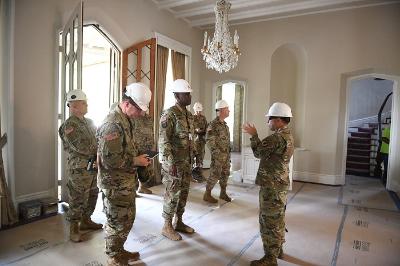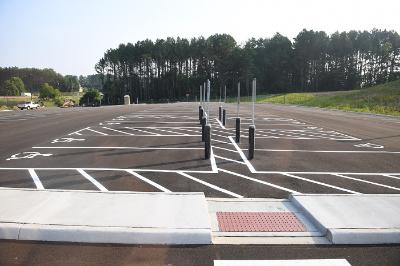Construction Updates
VMI Construction May Impact Your Visit to Lexington
Significant construction projects continue through 2022 and may impact traffic and parking on the post of Virginia Military Institute as well as downtown Lexington.
Ongoing projects include:
Aquatic Center—The Aquatic Center, also known as the Corps Physical Training Facility Phase III, is starting to look closer to the finished product, at least from the outside. Passers-by on North Main Street have seen massive walls go up with the framing for large windows. The work has continued steadily, with brief halts for holidays and snowstorms.
The road in front of the facility was closed to traffic for several days in February as a 375-ton crane was brought in, and a lane was created to place and lift the roof beams. The glulam beams are laminated wood, with each being 90-inches deep and 18-inches wide. Col. Keith Jarvis ’82, director of construction, explains that “in this kind of [aquatic] environment, all the chemicals used can be detrimental to a typical steel beam. The glulam works fantastic for this.”
Once the roof is placed, which should wrap up in March, the focus will be the inside. The construction of the actual pool will begin and the initial water fill will be done in August. During the summer and fall, focus will be on windows, interior construction and finishes, as well as completion of the heating, ventilation, and cooling system.
The 50-meter pool will hold 800,000 gallons of water. It can be divided into three sections, meaning diving, water polo, and competitive swimming could be happening all at the same time.
“This will be for the entire Corps of Cadets,” says Jarvis. NCAA teams will use it for practice and competition, but ROTC and the Department of Physical Education will both also use it for training. Cadet clubs, like the scuba club, will also find it valuable.
Just next door, the historic American Legion building, also known as the Knights of Pythias building, is under continued renovation and will be connected to the Aquatic Center. The main level will have coaches’ offices and a conference room. The upper level will be classrooms.
The $44 million project, which has been in the planning stages for about a decade, is a little more than halfway done, and the team guiding the project is working towards a November 2022 completion. “It’s a joy to see a project come together and get used. Then we move on to the next project. There’s always something to look forward to,” said Jarvis.


The Superintendent’s Quarters is also being made accessible for those with mobility challenges. A ramp is being built from the sidewalk to the side door closest to the commandant’s office, and a first-floor bathroom is being renovated to comply with current accessibility requirements.
Because the Superintendent’s Quarters is one of the oldest buildings on post, and is both listed as a National Register property and as a National Historic Landmark, its renovation has been undertaken in consultation with architectural historians at the state Department of Historic Resources. Work is scheduled for completion in the early summer of 2022.
Completed Construction Projects:
Scott Shipp Hall – The Scott Shipp Hall ribbon cutting on Saturday, Jan. 29, in collaboration with the Board of Visitors meetings, celebrated a five-year planning, design, and construction effort totaling $43 million. The project included a 28,000-square foot expansion and a complete renovation of the previously-existing 68,000-square foot space. Progress could be seen from just about every area of post over the years, including from the home-team seats in Foster Stadium. A beloved giant crane in place from fall 2019 until summer 2020 across from Crozet Hall practically became a part of the Corps through frequent social media posts from cadets.
The wrap-up of the most recent expansion and renovations of Scott Shipp Hall came at a time when materials were hard to come by or delayed due to the effects of the coronavirus pandemic. Ironically, when the groundbreaking of the facility happened in the summer of 1918, material shortages were a problem for the workers then, as well, due to the impacts of World War I.
In addition to being the home to multiple departments’ classrooms and offices, including history, economics, international studies, English, rhetoric and humanistic studies, the building has a photography lab, an art studio, a 70-seat auditorium, and courtyards for outdoor study. In addition, it now holds a 3,600-square foot space for the John Adams ’71 Center for Military History and Strategic Analysis.

Chessie Nature Trail Bridge – A long-awaited project for the community has been completed. A pedestrian bridge carrying the Virginia Military Institute-owned Chessie Nature Trail over the South River opening on December 10, 2021.
The new 210-foot structure, which can withstand winds up to 140 mph, replaces the original railroad bridge that was taken out by Hurricane Isabel in 2003. The $2.1 million project was possible because of the generous support of local partners including the City of Buena Vista, City of Lexington, Rockbridge County, and partners from the Federal Highway Administration’s Eastern Federal Lands Access Program. A new parking area, landscaping, and benches were also unveiled.

Plaza In Front of Marshall Arch – In the summer of 2021, a new project was completed that provides enhanced accessibility to the Parade Ground, honors the sacrifice of Allied soldiers in World War II, and recognizes the international contributions of Gen. George C. Marshall, VMI Class of 1901. The project, which was completed with the help of architectural and engineering firm Wiley|Wilson and staff from Physical Plant, relocated the visual focus of the Parade Ground to New Barracks.
New flagpoles, each 80 feet tall, were placed on either side of the statue of Marshall, and a 21-panel granite hardscape was built in front of the statue. Flanking the statue are two sets of stairs and two ramps, providing access to the Parade Ground for people who use mobility devices. The entire project was designed with Marshall and his contributions, particularly those during World War II, in mind. While Marshall served in multiple roles after the war, among them secretary of state, secretary of defense, and architect of the European Recovery Program, commonly known as the Marshall Plan, he was instrumental as Army chief of staff throughout World War II as he led the largest military expansion in U.S. history.
More information is available in the September 2021 Institute Report.


Anderson Drive – Construction of a new, two-lane bridge over Woods Creek on Anderson Drive was finished just before matriculation in August 2020. The road now curves more gently as motorists exit main post and head toward Jordan’s Point. Turning off the previous, one-lane bridge required a 90-degree turn, but the new bridge has an easier turn to navigate. The project also added a sidewalk leading from the Marshall Hall parking lot to Gray-Minor Stadium.

Preston Library - Near the end of August, an event central to VMI’s educational mission quietly took place: the reopening of Preston Library to the VMI community after a $19.3 million renovation – the library’s first in nearly 25 years. Prior to the renovation, the library entrance, the fifth floor, was somewhat dark and involved two sets of doors. Now, visitors walk through one door into a brighter, wider vestibule and can see the service desk just to the right of the elevator straight ahead.
Likewise, the seventh floor of the library, once inaccessible by elevator, is now accessible. That floor, formerly home to the Mathematics Education and Resource Center (MERC), is now the site of a conference room boasting what could be the best view on post of the Parade Ground—and House Mountain as a bonus in the background.
The sixth floor provides space for academic support services—the MERC, the VMI Center for Undergraduate Research (VCUR), and the Office of Sponsored Programs, which supports faculty research. It is also home to a large study space for cadets and rows upon rows of books.
One floor below on the main floor of the library, where library patrons and visitors enter off Letcher Avenue, is the Turman Room, redone with conference room-style seating. With the need for social distancing, and classroom space in short supply, the Turman Room was used as a classroom. In addition, the newly renovated learning commons features a bank of computers for cadet use, and offices for reference librarians close by.

VMI Police Headquarters – The $5.6 million project to create a new home for the VMI Police, with nearly 11,000 square feet of space was completed in the Fall of 2020. The building itself has been built to withstand the 180-mile-per-hour winds of a Category 4 hurricane. Inside, there is bulletproof glass between staff and visitors, along with dedicated rooms for processing evidence and fingerprints. Upstairs, an emergency operations center (EOC) with a smart whiteboard and televisions for news broadcasts will be able to accommodate eight people working in it at once.

.svg)
.png)